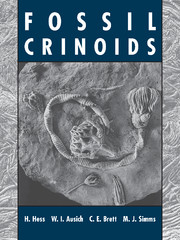Book contents
- Frontmatter
- Contents
- List of Contributors
- Acknowledgements
- Prelude
- Introduction
- GENERAL PART
- ASSEMBLAGES
- 6 Middle Ordovician Trenton Group of New York, USA
- 7 Middle Ordovician of the Lake Simcoe Area of Ontario, Canada
- 8 Upper Ordovician of the Cincinnati, Ohio, Area, USA
- 9 Silurian of Gotland, Sweden
- 10 Middle Silurian Rochester Shale of Western New York, USA, and Southern Ontario, Canada
- 11 Scyphocrinitids from the Silurian–Devonian Boundary of Morocco
- 12 Lower Devonian Manlius/Coeymans Formation of Central New York, USA
- 13 Lower Devonian Hunsrück Slate of Germany
- 14 Middle Devonian Windom Shale of Vincent, New York, USA
- 15 Middle Devonian Arkona Shale of Ontario, Canada, and Silica Shale of Ohio, USA
- 16 Lower Mississippian Hampton Formation at LeGrand, Iowa, USA
- 17 Lower Mississippian Burlington Limestone along the Mississippi River Valley in Iowa, Illinois, and Missouri, USA
- 18 Lower Mississippian Edwardsville Formation at Crawfordsville, Indiana, USA
- 19 Upper Pennsylvanian LaSalle Member, Bond Formation of Central Illinois, USA
- 20 Permian
- 21 Triassic Muschelkalk of Central Europe
- 22 Pentacrinites from the Lower Jurassic of the Dorset Coast of Southern England
- 23 Lower Jurassic Posidonia Shale of Southern Germany
- 24 Middle Jurassic of Southern England
- 25 Middle Jurassic of Northern Switzerland
- 26 Upper Jurassic Solnhofen Plattenkalk of Bavaria, Germany
- 27 Uintacrinus Beds of the Upper Cretaceous Niobrara Formation, Kansas, USA
- 28 Tertiary
- 29 Recent
- Appendix I Geological Time Table with Crinoid Assemblages
- Appendix II Glossary of Rocks
- Bibliography
- General Index
- Taxonomic Index
6 - Middle Ordovician Trenton Group of New York, USA
Published online by Cambridge University Press: 10 November 2010
- Frontmatter
- Contents
- List of Contributors
- Acknowledgements
- Prelude
- Introduction
- GENERAL PART
- ASSEMBLAGES
- 6 Middle Ordovician Trenton Group of New York, USA
- 7 Middle Ordovician of the Lake Simcoe Area of Ontario, Canada
- 8 Upper Ordovician of the Cincinnati, Ohio, Area, USA
- 9 Silurian of Gotland, Sweden
- 10 Middle Silurian Rochester Shale of Western New York, USA, and Southern Ontario, Canada
- 11 Scyphocrinitids from the Silurian–Devonian Boundary of Morocco
- 12 Lower Devonian Manlius/Coeymans Formation of Central New York, USA
- 13 Lower Devonian Hunsrück Slate of Germany
- 14 Middle Devonian Windom Shale of Vincent, New York, USA
- 15 Middle Devonian Arkona Shale of Ontario, Canada, and Silica Shale of Ohio, USA
- 16 Lower Mississippian Hampton Formation at LeGrand, Iowa, USA
- 17 Lower Mississippian Burlington Limestone along the Mississippi River Valley in Iowa, Illinois, and Missouri, USA
- 18 Lower Mississippian Edwardsville Formation at Crawfordsville, Indiana, USA
- 19 Upper Pennsylvanian LaSalle Member, Bond Formation of Central Illinois, USA
- 20 Permian
- 21 Triassic Muschelkalk of Central Europe
- 22 Pentacrinites from the Lower Jurassic of the Dorset Coast of Southern England
- 23 Lower Jurassic Posidonia Shale of Southern Germany
- 24 Middle Jurassic of Southern England
- 25 Middle Jurassic of Northern Switzerland
- 26 Upper Jurassic Solnhofen Plattenkalk of Bavaria, Germany
- 27 Uintacrinus Beds of the Upper Cretaceous Niobrara Formation, Kansas, USA
- 28 Tertiary
- 29 Recent
- Appendix I Geological Time Table with Crinoid Assemblages
- Appendix II Glossary of Rocks
- Bibliography
- General Index
- Taxonomic Index
Summary
A QUARRY FOR COLLECTING TRILOBITES AND ECHINODERMS
Classic outcrops of the Middle Ordovician Trenton Beds are exposed along the Trenton Gorge of West Canada Creek and in Mill, Cincinnati, and other creeks tributary to the Mohawk River at the town of Trenton, Madison County, New York, north of the Mohawk River valley (Fig. 71). A small hand-operated quarry on the property of W. Rust, about 1 km east of Trenton Falls, was opened by the Rust family and Charles Walcott for the purpose of collecting spectacular trilobite and echinoderm fossils from the upper beds of the Trenton Group.
Limestones of the Trenton Group are of late Middle Ordovician age (Trentonian or Caradocian Series, Mohawkian Stage), about 460 million years before present. The productive strata for crinoids occur in the Rust Member of the Denley Formation (Figs. 72, 73).
SHALLOW PLATFORM, RAMP AND BASIN
The Trenton Group comprises some 100–130 m of highly fossiliferous, thin-bedded, grey limestones with thin interbeds of dark grey calcareous shale. Limestones include a variety of lithologies, such as pelmatozoan-rich skeletal and rubbly nodular limestones with remains of bryozoans and pelmatozoans and tabular, graded micritic limestone. The latter have sharp bases, internal planar to cross-lamination and, in some instances, perfectly preserved fossils, including crinoids.
The coarser skeletal limestone facies are considered to have been deposited in shallow shelf settings. These beds show various amounts of winnowing by storm-generated waves and currents. Nodular calcarenites have undergone thorough bioturbation and, in some cases, early diagenetic cementation. The fine-grained lime mudstone beds reflect rapid deposition from low-density turbidity or gradient currents.
- Type
- Chapter
- Information
- Fossil Crinoids , pp. 63 - 67Publisher: Cambridge University PressPrint publication year: 1999
- 8
- Cited by



